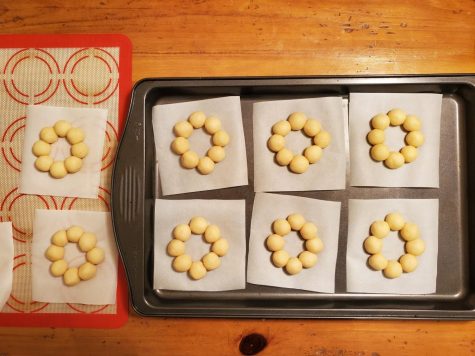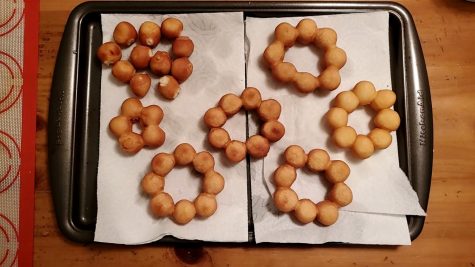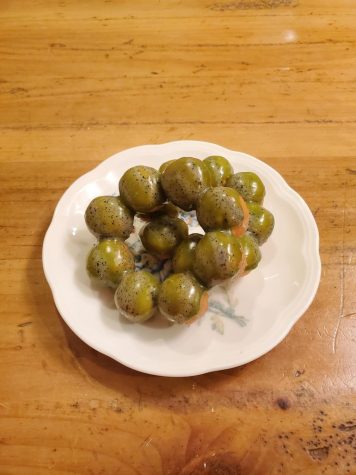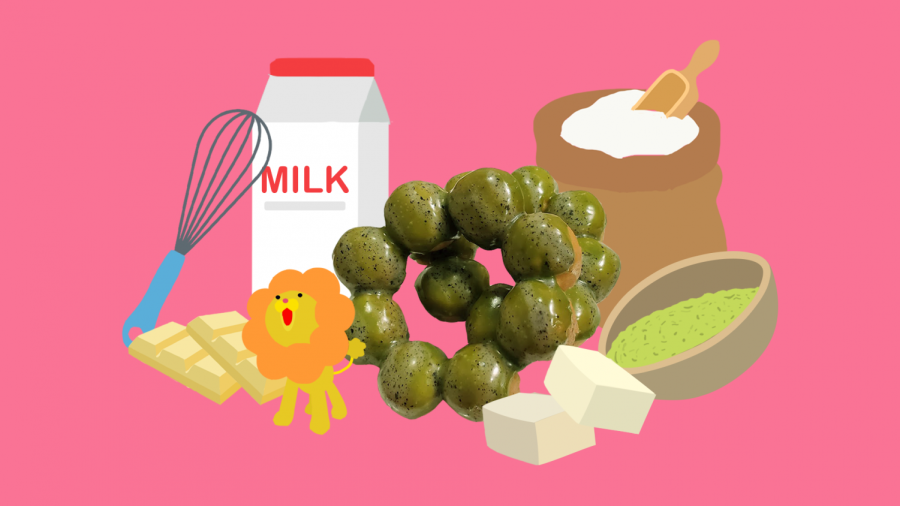Copycat recipe review: Mister Donut’s “Pon de Ring” Mochi Donuts
A novice’s attempt to fry donuts
Graphic illustration by Claire Chiu; photo by Claire Chiu
Mochi donut ingredients and the signature lion mascot of Mister Donut.
January 25, 2021
As a child, summer visits back home to Taiwan always meant a trip to Mister Donut, a popular donut chain in Asia, for a mochi donut. A mochi donut is made of tapioca rice flour, giving it its unique and springy chewy texture, one that is different from traditional donuts. Although I have sampled various mochi donuts in the U.S., none satisfied my craving for the original nor replicated the same cloud-like feeling of the dough. So, in an attempt to fulfill my foodie needs, I sought to recreate Mister Donut’s famous “Pon de Ring.”
In 2003 — coincidentally, the year I was born — Mister Donut released their newly developed mochi donut made with the same promise of both quality ingredients and taste. The secret to the unique texture of these donuts is silken tofu and tapioca flour, which can be substituted for glutinous rice flour. Silken tofu has the most water content out of all types of tofu and gives the donut dough its moisture.
Knowing that, I decided to measure out my ingredients in bowls to make the process efficient and prevent my dough from drying out. Surprisingly, when combining the dry ingredients with the wet ingredients, the texture of the dough was different from anything I had ever worked with since it was more moist than I expected. It felt like playdough. I set it to rest for 15 minutes and then divided the dough up into even pieces. Afterward, I shaped each piece into a small sphere and assembled each group of eight on parchment paper in the design of a flower. So far, the recipe felt very beginner-friendly.

Although I had many experiences baking cream puffs, cakes and cookies, I had never made donuts before, let alone mochi donuts, so my biggest obstacle going into this challenge was frying the donuts until they became the desired golden color. I was not about to waste my beautiful dough babies and cups of oil on burnt donuts, so I used a cooking thermometer to gauge the oil temperature. The first donut effortlessly slipped off the parchment once I flipped them over, giving me hope that the rest of the batch would be just as successful. The kitchen smelled like Disneyland churros. A couple mishaps occurred along the way — one or two donuts split apart while frying — but I salvaged the parts by turning them into donut holes. Thirty minutes later, six teething-ring shaped donuts were born!

I began to make the two types of glazes, matcha and black sesame. When I was younger, I opted for more cloyingly sweet flavors like double chocolate, but after years of developing my palate, I have grown fond of complex flavors like tea and sesame. The glaze recipe called for a white chocolate and heavy whipping cream base. The next step was extremely simple: I melted the chocolate and whipping cream, then added matcha powder and black sesame powder. Once the glazes cooled down, I dipped my donuts in matcha glaze, drizzled on the black sesame glaze and left them to set on a wire rack.

After dinner, it was time to dig in. The donuts had cooled so the texture was firmer than expected; however, a few seconds in the microwave returned them to their springy state. However, even after microwaving it, my recreation’s texture did not replicate that of the original; it was more dense. The flavor was too sweet for my liking, as the donut was already sweet so adding the glaze just made the sweetness too strong. Although the dish I recreated was not the same as Mister Donut, my attempt had its own virtues. I enjoyed the crunchy outside and its stark contrast to the soft interior.
My results were somewhat successful and in the future, I would increase the frying temperature to prevent overcooking and stick to a powdered sugar glaze instead. I enjoyed how the bitter matcha balanced out the sweetness, so the mochi donuts are best paired with sour or even savory flavors such as lemon and peanut butter. I suggest sprinkling on some chopped nuts for the ultimate dynamic texture experience. For beginners to frying, I absolutely recommend using a cooking thermometer. And just for extra assurance, dip the back of a wooden spoon into the pot of oil. If there are small bubbles rising to the top, you are all set to fry!
Making these mochi donuts brought back nostalgia for how my family would always buy a box of Mister Donut once we arrived to mark every Taiwan trip we made, no matter how late we flew in. To me, mochi donuts mean family and unity, so being able to successfully recreate those memories was the icing on the donut.





























































Randy • Jun 19, 2021 at 5:39 am
Mister donut Pon de Ring, does not contain tofu. It’s tapioca and bread flour.
donutman • Feb 22, 2022 at 3:56 pm
Agreed!